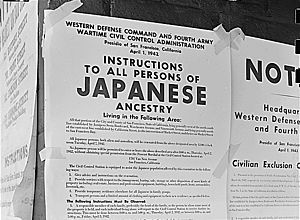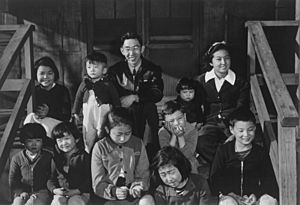Manzanar Children's Village facts for kids
The Manzanar Children's Village was a special orphanage for children of Japanese heritage. These children were held there during World War II. This happened because of a government order called Executive Order 9066. This order made President Franklin D. Roosevelt force Japanese Americans to leave their homes on the West Coast of the United States.
The Children's Village was located inside the Manzanar concentration camp in California. From June 1942 to September 1945, a total of 101 orphans lived there.
Contents
Why Japanese Americans Were Sent to Camps
After the Attack on Pearl Harbor in December 1941, many Americans were worried. On February 19, 1942, President Roosevelt signed Executive Order 9066. This order allowed military leaders to create special "military zones." From these zones, "any or all persons" could be removed.
Soon after, it became clear that Japanese American residents had to leave these zones. This included all of California and parts of Washington, Oregon, and Arizona. Over the next five months, more than 110,000 Japanese Americans were forced to move. They were sent from their homes to isolated camps far inland.
Who Lived at the Children's Village?
Before the war, most Japanese American orphans lived with relatives or foster families. Some lived in special orphanages in California. About two-thirds of the orphans who came to Children's Village were from these homes. Some staff members from these orphanages also came to Manzanar to care for the children.
Other children were not orphans before the war. After the attack on Pearl Harbor, the FBI arrested many Japanese American men. These men were often community leaders or business owners. They were suspected of being disloyal to the U.S. government. Over 5,500 men were arrested and sent to special camps. If their children had no other relatives to care for them, they became orphans. Many of these children later came to the Children's Village.
Some children at the Village had lived with non-Japanese foster families before the war. Because their foster parents were not forced to leave the West Coast, these children were taken from their homes. This happened if officials found out they had Japanese ancestry. Sometimes, foster parents turned the children over to authorities themselves. This was because they were afraid of breaking the new rules.
Many of the children at the Manzanar orphanage were very young. Half of them were under seven years old when they arrived. About 29 percent were less than four years old. Some of these children were of mixed heritage, meaning they had Japanese and other backgrounds. Some did not even know they had Japanese ancestry until army officials found out by checking old records.
Life Inside the Children's Village
Orphanage staff tried to stop authorities from sending the children to camps, but they were not successful. A military official, Colonel Karl Bendetsen, said that if anyone had "one drop of Japanese blood," they had to go to camp. He ordered the removal of children from orphanages on April 28, 1942.
Lillian Iida, a social worker, strongly opposed the Army's first plan. The Army wanted to split the orphans among staff members and send them to different camps. Because of Lillian's efforts, the Children's Village was built at Manzanar. Lillian and her husband, Harry Matsumoto, then ran the Village for the first few years.
On June 23, 1942, 61 children were taken by bus, under armed guard, from Los Angeles to Manzanar. Over the next few months, about thirty more children arrived from other states. Even babies born to unmarried mothers in other camps were sent to Children's Village.
The Children's Village had three main buildings. One was for staff apartments and shared spaces. The other two held the children's dormitories. It was located near the hospital at the northwest end of the Manzanar camp. The orphanage had its own running water, kitchen, and bathrooms. It operated mostly separately from the rest of the camp.
Harry and Lillian Matsumoto led the children in a daily routine. This included breakfast, a Christian service, school, homework, playtime, and dinner. Younger children went to bed early, and there was a curfew for everyone else.
The children at the Village did not interact much with other Japanese Americans in Manzanar. Because the orphanage had its own facilities, they did not need to leave often. They ate their meals inside the orphanage with their caretakers, separate from other camp residents. Also, other children in the camp were sometimes told by their parents not to play with the orphans. This made the children in the Village feel very isolated.
After the War
In late 1944, President Roosevelt announced that Japanese Americans could return to the West Coast starting in January 1945. Most of the camps closed during that year. When Manzanar was going to close, officials and staff at the Children's Village had to decide where to send the children. Most children went back to the group homes they came from or went to live with relatives.
Some children's records were lost, or they did not have a guardian. These children stayed in the Village while authorities tried to find their relatives or a legal home for them. When the Children's Village closed in September 1945, these children were placed with adoptive parents or sent to foster homes and other institutions.
The story of the Manzanar Children's Village was not widely known for many years. But in the late 1980s, Francis Honda, who was an orphan there, shared his experiences. Today, the Manzanar Children's Village buildings are no longer standing. However, there is an informational display at the site. There is also an oral history project at California State University, Fullerton. This project has interviews with former residents and staff members.
Further information
- Children's Village Oral History Project. California State University, Fullerton. Center for Oral and Public History.
- Catherine Irwin, Twice Orphaned: Voices from the Children's Village of Manzanar (Fullerton, CA: Center for Oral and Public History, 2008).
- Lisa Nobe, "The Children's Village at Manzanar: The World War II Eviction and Detention of Japanese American Orphans." Journal of the West 38.2 (April 1999): 65-71.
- Helen Whitney, "Care of Homeless Children of Japanese Ancestry during Evacuation" (M.A. thesis, University of California, Berkeley, 1948).
- Densho: The Japanese American Legacy Project





